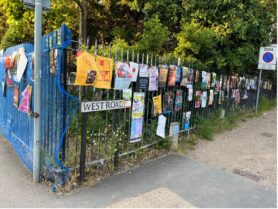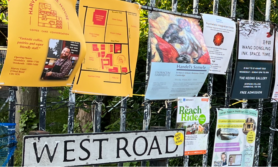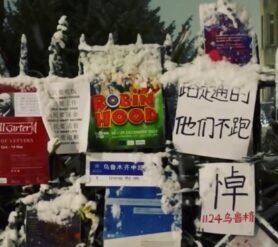[urban interfaces] Blogs
Guest blogpost : Yu Sang – The Hybrid Urban Wall: Materiality, Messages, and Materiality
For our [urban interfaces] seminar series on the theme Creative Urban Methods (year 2022-2023), we invited participants to write blogposts. The best and most interesting ones we publish on our website.
Below is the blogpost for seminar session #2, written by Yu Sang:
Yu Sang is currently a research Master’s student in Media Studies at the University of Amsterdam, with a specialization in Television and Cross-Media Culture. Her research interests are in the intersection of environmental media, infrastructure studies, and urban studies. Prior to pursuing her Master’s degree, Yu completed a Bachelor of Science in Interactive Media Art at New York University, where she was involved in several research projects related to urban design and public art.
The Hybrid Urban Wall: Materiality, Messages, and Materiality
By Yu Sang
Without posters on it, it would merely be recognized as a fence. Yet, when various posters are hung on the fence, the fence is transformed into a wall. It is not important to distinguish a wall from a fence. While the distinction between a wall and a fence might seem trivial, the ambiguity underscores the intricate nature of urban interfaces.

At the beginning of the fall semester, I headed to Cambridge for the first time to visit my friend at Selwyn College. As I approached the juncture of Grange Road and West Road, I found myself captivated by the fences teeming with vibrant posters, including event announcements, restaurant promotions, and collegiate notices. This hybrid entity not only safeguarded the private gardens of King’s College from curious passersby but also served as a dynamic public interface, updating what was new in the city. It defied easy categorization, being more intricate than a mere fence, wall, or city billboard. I will tentatively label it as the unsolid and contingent wall, which dynamically changed its form and message during the interaction with the urban environment.
Wall as Urban Mediator
The conception of interface in media and communication studies is closely tied to technology, particularly focusing on human-computer interaction. Even in dynamic urban settings, the discussion around interfaces predominantly revolves around the ubiquitous digital screens (Mattern 2014; Degen and Rose 2022). Yet, both Shannon Mattern, Degen and Rose have made efforts, whether directly or indirectly, to disentangle the idea of the interface from mere screens, suggesting that urban interfaces serve as mediating spaces where citizen experiences, power dynamics, and urban imaginaries converge. As Johanna Drucker articulates, an interface is not merely an abstract tool for interacting with technologies but also “an object” that is physically being and “a space that constitutes reading as an activity” (2013, 213).
Given this broader understanding of interfaces, I wonder whether we can think of the urban wall under the conception of interface with such a mediating capacity. For me, the term interface is sometimes misleading. It often conjures an image of a smooth and flat plane, where only the message displayed holds significance. Sabina Andron’s article “Interviewing Walls: Towards a Method of Reading Hybrid Surface Inscriptions” (2016) shows this tendency when approaching urban walls. She focuses on the inscriptions rather than the wall itself, treating the wall as a surface. Despite the value of her methods in addressing issues of ownership, materiality, and communication, the wall remains an overlooked entity. Yet, as a mediating space, the wall has its own narrative and significance. In the following part, by “interviewing” a specific wall at Cambridge, I want to delve into its materiality and rethink its mediating role in urban life.
Emergence of a Hybrid Wall
This fence belongs to King’s College, while these colorful posters belong to and also speak to the entire city. This union creates a hybrid entity that defies easy classification, suspended between the realms of public and private. I propose to see it as an unsolid and contingent wall, constituted by fences and posters, formed temporally and incrementally during intensive human activities. People put posters on the fence to attract passersby’s attention, which effectively opens the fence to the public and announces its public nature.
The role of these posters is not merely symbolic; they serve as the foundational fabric for this evolving hybrid wall. They function both message and surface, gaining significance not in isolation, but in aggregation. A lone poster or two barely registers a glance. But as they amass, they create a visual spectacle, uniting to command attention and jointly becoming an interface to display information and a platform for sharing messages. This process enriches and extends the primary role of the fence from just safeguarding the private garden to acting as an urban wall or interface. This transformation speaks to the fluid, dynamic, and collaborative process that constructs our urban spaces. The interaction between the fence, posters, and various contributors, from students to shopkeepers, constantly form and reform the wall. This wall is no longer an immutable urban fixture but an evolving and responsive entity within the urban system.


Being Visible
As Sabina Andron observes, “urban surfaces are home to a constant battle for visibility taking place between the most unequal of forces” (2016, 74). Such a battle for visibility between different visual and textual signs is less apparent in normal days. The posters, while competing for attention, seem to coexist harmoniously, eschewing any direct encroachment upon their neighbors. Only the sticker “not my king,” a political symbol advocating for the monarchy’s dissolution, was put on the official street sign “WEST ROAD.” Despite its placement, the sticker remains less noticeable due to its smaller size and colorful posters around it. It seems the sticker does not intend to speak loudly on campus.
Among so many colorful posters, being prominent is not an easy task. While many of them on this hybrid wall might not compete fiercely for attention, they still need attention in certain moments. The Chinese political posters are one such example. In December 2022, the conflicts between authorities and the public regarding the strict anti-zero-covid policy were further intensified due to the Ürümqi fire event. Given China’s strict censorship landscape during this period, the wall became one global site for citizens to amplify their political dissent. These political signs with Chinese handwriting characters stood out among others. They broke away from the conventional designs and featured bold, black, handwriting font and a larger font size that can grab passersby’s attention and arouse their curiosity even from a distance. Their impactful designs, such as the bold Chinese characters 悼 (mourn) or the phrase mocking the government’s fire explanation, serve as powerful visual narratives. As Andron suggests, the complex semiotic system in the urban surface reflects the dynamics in the cities, such as “its artistic inclinations and political grievances, its social policies and cost of life, and its inhabitants’ problems, passions and preoccupations” (2016, 77). While most of the time, this wall is more like a billboard for Cambridge, at this special moment, it emerged as a contingent interface for global political dialogue.
Visibility, however, is not only about the content but also related to the locality, environment, and materiality of the wall, which can influence how these posters are perceived and how long these posters can be present. The structure of the fence determined the way of setting posters. Its gridwork precludes easy affixing, leading people to use hard plastic ropes for securing their messages. When the posters are taken off, these plastic ropes are always left, becoming intrinsic elements of the wall. They, in turn, influence the positioning of subsequent posters, shaping the wall’s evolving appearance. Posters’ material also plays a decisive role in their longevity and, consequently, their visibility. Even though paper is most accessible for students, especially for casual or personal campaigns, it deteriorates faster than paints or stickers in adverse weather. Handwriting paper is also more vulnerable to rain or snow than more “official” announcements from colleges or departments using high-quality paper and inks, which presents another layer of ephemerality. Although most of the posters in Cambridge are from students, a noticeable differentiation exists in sources, purposes, and production conditions, which impacts their durability and visibility.
Conclusion
In this blog, I explore not only the formation and evolution of the wall but also the textual-visual inscription upon it. I want to emphasize that they are not two separate subjects about the urban wall. The conversation is not just about materials, locality, or communication in isolation; it’s about how these elements interweave, grounding human experiences and activities in a vibrant urban environment. The wall, with its ever-shifting appearance of posters, serves as a testament to the transient yet poignant nature of human experience, an interface that is as much about the message as it is about the medium. It is not merely a static backdrop but a dynamic entity, actively participating in the dialogue of urban life. Drawing upon ideas from Donna J. Haraway’s recent book, Staying with the Trouble (2016), “all the players rendered each other capable; they become with each other in speculative fabulation” (22), this hybrid wall exemplifies a process of “becoming-with” and “co-producing” involving both human and non-human actants. It is no longer a passive receptacle of human expressions but an active participant in the complex, dynamic coexistence and mutual influence in urban life.
Bibliography
Andron, Sabina. 2016. “Interviewing Walls: Towards a Method of Reading Hybrid Surface Inscriptions.” In Graffiti and Street Art, edited by Konstantinos Avramidis and Myrto Tsilimpounidi, 1st ed., 71–88. Routledge.
Beresford, Jack. 2023. Newsweek. https://www.newsweek.com/anti-monarchy-king-charles-iii-republic-coronation-protest-1798576. Accessed May 31, 2023.
Degen, Mónica Montserrat, and Gillian Rose. 2022. The New Urban Aesthetic: Digital Experiences of Urban Change. London, UNITED KINGDOM: Bloomsbury Publishing USA. http://ebookcentral.proquest.com/lib/nyulibrary-ebooks/detail.action?docID=6844885.
Drucker, Johanna. 2013. “Reading Interface.” PMLA 128 (1): 213–20. https://doi.org/10.1632/pmla.2013.128.1.213.
Haraway, Donna J.. 2016. Staying with the Trouble: Making Kin in the Chthulucene. Durham: Duke University Press. Accessed May 2, 2023. ProQuest Ebook Central.
Mattern, Shannon. 2014. “Interfacing Urban Intelligence.” Places Journal, April. https://doi.org/10.22269/140428.

